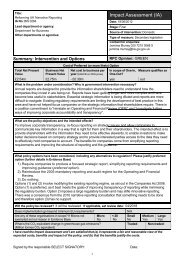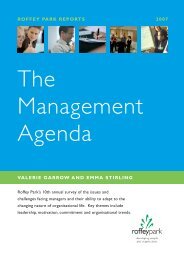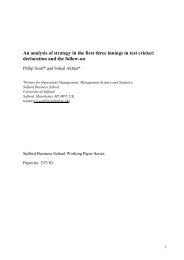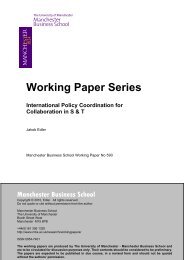survey - Management and Business Studies Portal
survey - Management and Business Studies Portal
survey - Management and Business Studies Portal
You also want an ePaper? Increase the reach of your titles
YUMPU automatically turns print PDFs into web optimized ePapers that Google loves.
The need for speedMost worrying is the slowresponse of UK companiesLessons learned<strong>and</strong> missedPage 5Page 7Fight orflight?How to survive <strong>and</strong> thrive in today’s economyThe longslow roadto recoveryFollowing a period of sustained growth we st<strong>and</strong> onthe brink of an economic downturn.With this uncertain climate inmind, Hay Group set out to takethe pulse of the UK economy, byinviting business leaders to sharetheir strategies for dealing with adownturn <strong>and</strong> more.Their responses are revealing.They suggest, <strong>and</strong> we agree, thatthe downturn will be short <strong>and</strong>shallow, but the recovery slow<strong>and</strong> painful. UK executives thenexpect a return to business asusual. We disagree: debt-fuelledconsumer dem<strong>and</strong> will ebb away,costs of raw materials will grow<strong>and</strong> international competitionwill intensify to create a lengthylean period for companies. Thiswill expose weak strategies, flabbyorganisations <strong>and</strong> half-heartedexecution previously masked bygeneral growth.Aggression during a shortdownturn is certainly justified,<strong>and</strong> many organisations areplanning an externally focusedstrategy, relying on expansion ofhigh performing units, fosteringgreater customer satisfaction<strong>and</strong> strategic acquisitions. But,we question the ability of manyto execute on these principles:performance managementsystems are weak, customerloyalty low <strong>and</strong> merger integrationfragile.The real test comes after thedownturn, during the recovery,when expectations will behigher. Our <strong>survey</strong> shows thatfew organisations are planningfor the recovery – though it maynot be far away. This is a mistake.Organisations were slow toreact to the credit crunch <strong>and</strong>see themselves as slow to reactto changing market conditions;successful executives will beginplanning now.Looking at the factors thatsustained growth after thelast major slowdown (in theearly nineties) we have evidencethat improving innovationthroughout the organisation;tightening performancemanagement to target costsavings at lower performers<strong>and</strong> staying close to customerswill all help. For companies thatuse this as an opportunity tomake acquisitions, due diligenceon intangible assets <strong>and</strong> strongpost-merger integration arealso essential.Companies which made themost of the last recovery weredistinguished more by theirexecution than their insight. The‘shock proof’ tactics required arenot rocket science, but they dodeal with the most intangibleaspects of the organisation.Theshock proofbusinessOur analysis suggeststhat the comingdownturn may bebrief <strong>and</strong> shallow...Full story on Page 11 >>
2Fightor flight? I How to survive <strong>and</strong> thrive in today’s economyContents2 The outlook:recession, downturn,slowdown...?3 MethodologyThree str<strong>and</strong>s of researchinto company performancein challenging economicconditions4 What UK industryexpects5 The need for speedMost worrying isthe slow responseof UK companies6 Policyrecommendations7 Lessons learned<strong>and</strong> missed11 The shock proofbusinessThe outlookReal economicactivity willdecline in2008 – 2009–– industry predictions–– cebr predictionspercentage3.53.0Theoutlook:recession, downturn,slowdown...?2.52.01.51.00.50.02007/08year2008/092009/102010/11Respondents were asked for annualgrowth in each year. cebr forecastsrelate to annual growth in GVA inQ1 of the relevant year except for2007/08 where actual growth rate asof Q4 2007 is used.The UK economy is currentlygoing through one of the mostdifficult periods in its recenthistory. With the impact of thecredit crunch still being felt,<strong>and</strong> with the US close to – or in– recession, most commentatorsforecast that the UK economywill experience less growth thanin any year since 1992. Consistentwith this, many indicatorsof consumer <strong>and</strong> businessconfidence are recording theirlowest level since these<strong>survey</strong>s began.At the same time, inflation,by recent st<strong>and</strong>ards, remainsstubbornly high. At the time ofwriting, consumer price inflation(CPI) was at 3.3 per cent, whichhas forced the Bank of Engl<strong>and</strong> towrite a letter of explanation to theChancellor. Moreover, the Bank’sown central forecasts suggest thatCPI is likely to reach 4 per cent bythe end of the year. Factory gateinflation is running at 8.9 per cent– the highest rate since 1986.<strong>Business</strong> leaders expectdifficult – but not catastrophic– times ahead. Real economicactivity will decline in 2008-2009 to record negligiblegrowth, before picking up again.Productivity performance willalso be poor, with the worstyear (2009-2010) showingbarely 1% productivity increase,as companies increase theirworkforces in expectationof growth.Senior leaders are generallybullish over the long termhowever. Although 33% ofexecutives expect to fall shortof target this year, <strong>and</strong> 28% tostruggle to grow at all, only 18%see trouble two years ahead <strong>and</strong> afurther 18% expect the downturnto have no impact on theirbusiness at all.Consistent with thesefindings, 81% of businessleaders expect the UK tomake a full recovery fromthis slowdown <strong>and</strong> returnto ‘business as usual’. Mostrespondents expect somegrowth throughout theentire downturn.Overall, the assessment frombusiness, in line with cebr’s ownforecasts, is that the most difficulttimes will be relatively short<strong>and</strong>, by historical st<strong>and</strong>ards,shallow. This is not a time formassive retrenchment or evenconservatism. It may in fact, bea time of opportunity for thosefirms employing the right tactics.
The outlook continuedMethodology“81% of business leadersexpect the UK to makea full recovery from this slowdown<strong>and</strong> return to ‘business as usual’percentage654”–– 1987–93–– 2004 –10Methodology3210–1–2Year 1 Year 2 Year 3 Year 4 Year 5 Year 6 Year 7Comparison of early 90’s with today – actual <strong>and</strong> forecast UK GDP growthAlthough there are similarities with theearly 90s – both periods show a slowdownfollowing a period of growth in borrowing<strong>and</strong> house price inflation – there are alsosignificant differences. We expect thecycle to be less violent this time round: theinternational economy is more developed,public finances are healthier <strong>and</strong> inflation,although rising, is much lower <strong>and</strong> so areinterest rates.Another difference between the currenteconomic cycle <strong>and</strong> its predecessor is thatinterest rates today are not the only factoraffecting monetary behaviour.Banks have lost money as a result ofrisky lending decisions made during theupswing. This has affected their willingness<strong>and</strong> ability to lend. Whereas the declinein bank lending growth in the 1990s wasmore a reflection of weak dem<strong>and</strong> againsta stagnant or declining property market,the decline expected this year <strong>and</strong> next, ismore a reflection of banks’ unwillingnessto lend than customers’ unwillingness toborrow.Although the downturn itself may be‘gentle’ we can, however, expect a moreprolonged period of sluggish growththereafter. This is largely the result of highcommodity price inflation constrainingthe monetary policy committee (MPC)from reducing interest rates too sharplyin the near term - certainly compared tothe rapid declines in interest rates thathave been seen in the US. Furthermore,although sterling is not in an exchangerate mechanism, it is likely that, even whenthe impacts of commodity price inflationhave worked their way through, the MPCwill be worried that too rapid a fall in UKrates would risk an inflationary slide in thepound. Meanwhile, fiscal tightening is alsolikely to hold back growth.On top of all this, the UK’s competitiveadvantage of relatively low taxes <strong>and</strong> a lowratio of public spending to GDP comparedwith its European competitors is graduallyeroding. In 1998 UK public spending, as ashare of GDP, was 40% while the equivalentratio for the eurozone was 48%. Thelatest forecasts from the Organisation forEconomic Co-operation <strong>and</strong> Developmentshow that by next year the ratios will bevery close together – 44% for the UK <strong>and</strong>45.6% for the eurozone.Our conclusion, therefore, is that,although a moderate response to theimmediate downturn is reasonable, we willnot see a quick return to business as usual.In this regard, the 81% of UK business whoexpect no radical change to the economyare perhaps too complacent. It is the periodafter the downturn which will be morechallenging <strong>and</strong>, as we will see later, toofew organisations are currently planningfor it. The rising tide of consumer dem<strong>and</strong>that lifted all boats is on the ebb <strong>and</strong> willexpose flabby organisations <strong>and</strong> ‘me too’strategies. Success will require a tougher,fitter organisation, flawless execution <strong>and</strong> amastery of a number of disciplines on whichUK Plc’s current record is poor.It is the period after the downturn which will be more challenging<strong>and</strong> too few organisations are currently planning for it.This paper is based on threestr<strong>and</strong>s of research into companyperformance in challengingeconomic conditions:• Hay Group commissioned the Centrefor Economics <strong>and</strong> <strong>Business</strong> Research(cebr) to conduct an analysis of currenteconomic conditions in comparison toprevious downturns <strong>and</strong> recessions• cebr <strong>and</strong> Hay Group analysed the resultsof a detailed opinion study of 120senior executives about their company’sperformance, expectations <strong>and</strong> responsesto current economic conditions• Hay Group analysed the performanceof companies in four sectors (cyclical<strong>and</strong> non-cyclical) during <strong>and</strong> after thelast major recession in the early 90s. Welooked for companies that outperformedtheir sectors in both time periods <strong>and</strong>investigated what they did that wasdifferentTogether, these str<strong>and</strong>s enable us to describecommon responses to the downturn<strong>and</strong> to make a broad assessment of theireffectiveness given previous experience.Throughout, our focus in particular is ontalent, leadership, incentives <strong>and</strong> organisationdesign – the human elements of companyperformance. These are increasinglyrecognised as fundamental to long termsuccess <strong>and</strong> extraordinarily vulnerable tobad choices during difficult times.
4Fightor flight? I How to survive <strong>and</strong> thrive in today’s economyExpectationsWhat UKindustryexpectsIn line with the economicanalysis, the majority ofcompanies perceive a threatyet see no need to radicallychange their businessmodel or approach.The things that worry companiesthe most at this time are:• Having the wrong strategy formarket conditions• Loss of talent <strong>and</strong> key skills (57% saw itas a threat – 23% saw this as the mostsignificant threat)10080percentage of respondentsFinancial services firms are also concerned about the lackof debt capital, while industry worries about the escalatingcosts of raw materials. Smaller firms are particularlyconcerned about losing talent, <strong>and</strong> about whether they havethe leadership <strong>and</strong> experience to weather turbulent times.“Firms are particularly worriedabout losing talent”• all firms• financial services• other commercial6040200expect full recoveryexpect UK economyto be radically differentOnly 19% of companies expect the UKeconomy to be radically different after thedownturn.
StrategyThe needfor speedMost worrying is the slow response of UK companies.While half of respondentsadmit that they had the wrongstrategy, they also fear they aretoo slow at changing strategies.Of those companies that believethe downturn will affect theirbusiness, over a third beganplanning a response less thanfour months ago <strong>and</strong> a fifth areonly just starting. The averagelength of time for preparationshas been around ten months –dating clearly from the start ofthe credit crunch.Just 13% are makingplans for the upturn. Givenour expectations about therelatively brief duration ofthe current conditions, <strong>and</strong>the difficult recovery, this is aconcern. It reinforces a senseof complacency <strong>and</strong> lack ofagility about the opportunitypresented. There is little panic,but equally little ambition.Given that many firms worrythat they have the wrongstrategy, what is driving theslow speed of response?The greatest barrier cited isshareholder focus on short termreturns, 49% of respondentssaw this as an obstacle. A further43% thought that the accuracyof long term forecasts madeeffective planning difficult.“There is little panicbut equallylittle ambition”Threats to business50403020100reduced funding for innovation(including R&D)percentageadjustedtargets butnot strategyleadership lacks vision<strong>and</strong> purposeinexperience of leadingin a downturntoo slow to implementnew strategyincreasing costs of rawmaterials or commodity pricesavailability of debt capitalwrong strategy formarket conditionsloss of best talent <strong>and</strong> key skills<strong>Business</strong> responseno changesnew strategyfor downturn• all firms• financial services• other commercial0 1 2 3 4no threat serious threatnew strategyfor downturn<strong>and</strong> upturnDid youknow?Just 13% of companies inthe UK are making plansfor the upturn. Given ourexpectations about therelatively brief duration ofthe current conditions, <strong>and</strong>the difficult recovery, this isa concern.
Policy recommendationskey attributes of6Fightor flight? I How to survive <strong>and</strong> thrive in today’s economyRecommendations<strong>Business</strong> leaders predict that the near term prospects for thedownturn leaderseconomy are poor but not dismal.In this context, we asked themwhat they believed policymakerscould do to improve theeconomic climate. Respondentswere asked to rank from one tofive various policy measures witha score of one for policies thatwould not be at all helpful <strong>and</strong>a score of five for policies thatwould be very helpful. In ouranalysis we provide an averagescore for each measure.The responses show a strongpreference for monetary <strong>and</strong>fiscal stimuli – either interestrate cuts or tax reductions– across the different sectorsconsidered. By contrast, trademeasures – either promotingfree trade or its converse, greaterprotectionism – were not seenas particular helpful policiesfor business. Protectionism,in particularly, was seen asmore likely to do harm thangood. There was also mutedenthusiasm for governmentintervention to promoteresearch <strong>and</strong> development– although this was somewhatmore supported by nonfinancial services companies – orfor (further) liberalisation of thelabour market.Of the tax measuresconsidered, lowering corporatetax rates was seen as more likelyto be helpful than loweringtaxation on individuals.However, there was much lessdiscrepancy in the score forthese two alternatives withinthe financial services sector.This most probably reflects thegreater international mobilityof labour within the financialservices sector <strong>and</strong>, possibly,the greater impact of theintroduction of the ‘non-dom’tax in this sector.implement tradeprotectionspush for open tradewith emerging marketsincrease flexibility oflabour marketsencourage R&D/innovationreduce taxon individualsrelease liquidity intothe financial marketsreduce interest ratesreducecorporation tax• all• financial services• other commercial0 1 2 3 4 5not helpful very helpfulPervasiveinnovationLess than 25% of executives believe their organisation’s ability toinnovate is adequate to drive value. Yet this is one of the key successfactors for ‘star’ performers in a downturn.Innovation is the application of creativity to value. New ideas, new way of doing thingsthat are converted into measurable benefits. The new focus of innovation is not justproducts <strong>and</strong> services but organisational design, process <strong>and</strong> culture. It is here thatprofound changes in quality <strong>and</strong> cost can be realised.Hay Group’s research over many years demonstrates that there are six keycompetencies for successful innovation:• Scanning – innovative companies regularly review the activities of competitors,suppliers, policy makers <strong>and</strong> opinion formers• Peripheral vision – innovative companies pay attention to events on the edge oftheir market-place, which may inspire new connections• Partnering – innovative companies work well with other organisations <strong>and</strong> therebytap into new ways of doing things• Customer intimacy – innovative companies pay particular attention to changes intheir customers’ lives <strong>and</strong> businesses• Sharing – innovative companies distribute such external knowledge across the business• Prioritisation – innovative companies are good at distilling the mass of externalinformation into a few clear priorities for development.
Lessons learnedLessonslearned<strong>and</strong>missedThis time around we are seeing a more sophisticated response to the conditions thanacross-the-board job cuts, with many executives pinning their hopes on an aggressive,outward facing strategy <strong>and</strong> taking the opportunity to eliminate underperformance.• reduce costs in lowmargin businesses• cut costs across the board• invest in growth markets• halt expansion• launch aggressive sales drive• reduce sales force numbers• reduce investment in innovation• increase investment in innovationRead Hay Group’s latestresearch report oncustomer retention,‘Lost in transaction’www.haygroup.co.ukCompanies recognise thatthey need to maintain theengagement of talented staff,<strong>and</strong> see an opportunity to weedout underperformers. Few seea need to radically change theirbusiness model, but many wantincreased efficiency. Lookingexternally, many pin their hopeson customer intimacy <strong>and</strong> somestrategic acquisitions. There aresignificant barriers to the successof all of these tactics.Outward facing strategiesThe sense of external focus isclear. 64% will be more likely tolaunch an aggressive sales drivethan cut sales force costs.73% will invest in expansion intonew growth markets rather thanhalt expansion. The two mostfavoured tactics for weatheringthe conditions were:• Customer satisfaction<strong>and</strong> retention – 77% ofrespondents overall, <strong>and</strong> 81%outside financial services• Strategic acquisitions – 67%are using the conditions asan opportunity to look foracquisitions at the right priceAs with retaining talent, thepractical application of thesestrategies may be problematic.The UK has the highest rate ofcustomer turnover in Europe(Pitney Bowes customer churn<strong>survey</strong>) <strong>and</strong> separate Hay Groupresearch suggests that 91% ofacquisitions fail to deliver thevalue they promised.It seems that, while manyfirms are adopting aggressive,externally oriented tactics, theymay lack the capacity to executethese tactics effectively. Agility,the retention of talent throughvision <strong>and</strong> customers throughservice, a focus on productivity,acquisitions at ‘fire sale’ prices– all look good on paper butexperience suggests that manycompanies will fail to deliver.
8Fightor flight? I How to survive <strong>and</strong> thrive in today’s economyLessons learned continuedProtectionof talent“many firms are adopting aggressive,externally oriented tactics, but theylack the capacity to executethese tactics effectively”Effective acquisitionA downturn may offer opportunities to make acquisitions but Hay Groupresearch suggests that 91% of mergers <strong>and</strong> acquisitions fail to meet theirobjectives. This is because executives concentrate on financial <strong>and</strong> systemsdue diligence <strong>and</strong> integration at the expense of the intangible assets.These factors are equally critical <strong>and</strong> include frontline ability to deliverbr<strong>and</strong> promise, client relationship management, human capital <strong>and</strong>leadership. The model below breaks them down into three key areas.Hay Group’s intangible assets modelOrganisational capital Relational capital Human capitalCulture <strong>and</strong> market Br<strong>and</strong> LeadershipconvergenceGovernance Client intimacy EmployeesAgility Client loyalty Development <strong>and</strong>managementCommunication <strong>and</strong> External networks EngagementteamingEnergy <strong>and</strong> clarity Internal networks ProductivityOrganisational structureHow do you persuade talent fromwalking when the going gets tough?Here are some basic points that canhelp organisations win in a downturn.• Provide clarity of strategy, direction <strong>and</strong> pace• Instil trust <strong>and</strong> confidence in your mostdriven, focused employees• Address fundamental concerns – everyoneneeds to know what is expected of them,their objectives <strong>and</strong> the behaviours theyshould be exhibiting• Put people in roles suited to their skills<strong>and</strong> ambitions• Provide the tools for people to do their jobs• Act quickly – the longer you wait, themore you create a vacuum, leavingemployees to worry <strong>and</strong> draw theirown conclusions.Tacit ‘know-how’ <strong>and</strong>innovation9 | 2007DangerousliasonsMergers <strong>and</strong>acquisitions: theintegration game.Following a meteoric 2006, corporate mergers <strong>and</strong>acquisitions have dominated the global business agendainto 2007. But mergers can prove a dangerous game. >>To find out moreabout this researchread Hay Group’sresearch report,‘Dangerous liaisons’www.haygroup.co.uk
Lessons learned continuedPerformance<strong>and</strong> productivityDid youknow?29% of firms will use the downturn as a chance to weedout underperformers, 10% will focus on recruiting talentat lower cost <strong>and</strong> 24% will do both. This implies that53% will weed out underperformers.A majority of companiesare expecting to reduceinvestment in innovation.This may weaken their abilityto capitalise on the recovery.Yet companies worry aboutthe effectiveness of theirperformance managementsystems in identifyingperformance <strong>and</strong> the roleof managers in toleratingrather than addressing poorperformance. Many respondentswill therefore rely on naturalwastage (45%) <strong>and</strong> only 28% willbe able to remove those whodon’t meet their targets.Many companies will beapplying this ‘health drive’ tobusiness units as a whole. 78%will focus cost cutting on lowperforming units rather than cutcosts across the board. 73% wantto channel investment into highperforming business units.Of great concern, however, isthe threat to innovation in manycompanies, with a slight majorityof companies expecting toreduce investment here. This mayweaken their ability to capitaliseon the recovery.Causes of poor performanceneed to retain all staffdue to tight labourUnion opposition /employment lawmanagement unwillingto take tough decisionsCulture of tolerating poorperformanceinadequate performancemanagement systems0 1 2 3 4 5unimportantvery important• total• financial services• other commercial
10Fightor flight? I How to survive <strong>and</strong> thrive in today’s economyLessons learned continuedPerformancemanagement“41% of employeesreport a lack ofclarity <strong>and</strong> engagement”<strong>Business</strong> leaders cited a lack of confidence in their performancemanagement systems as one of the key barriers to improvingproductivity in a downturn. In her recent book, ‘Managing <strong>and</strong>measuring employee performance’ Dilum Jirasinghe, AssociateDirector at Hay Group, draws on the experiences of the most admiredcompanies to identify best practices in performance management.• Balance development <strong>and</strong> measurement – look at both quantifiable measuresthat impact directly on the bottom line <strong>and</strong> aspects such as teamwork, long termthinking <strong>and</strong> managing talent• Deal with underperformance – ensure the HR department supports linemanagers to ‘manage performance’ <strong>and</strong> meet underperformance head on usingtechniques such as a forced distribution of performanceperformance across the whole organisationShifting the focus of innovation• One company, one approach – common templates <strong>and</strong> benchmarks of• Managing performance to implement strategy – clarity about individuals’accountabilities <strong>and</strong> how these fit into delivering the organisation’s strategy• Align pay to performance <strong>and</strong> in turn performance to strategy – make yourreward budget go further by encouraging executives to maximise their personalpay packets, by delivering on activities that are of strategic importance.Keeping talentFew organisations will use pay as aretention tool (either base salariesor bonuses) – with the exception offinancial services.Approaches to employee engagementincreasing bonuses orvariable payoffering flexibleworking/sabbaticalsRather, the preferred approachwas to communicate thecorporate vision more effectively.This has the advantage of beingcheap, but given that 41% ofemployees report a lack of clarity<strong>and</strong> engagement, this may notbe as easy as expected. Half ofall respondents outside financefeared their leaders lacked vision.Outside of the financialservices sector, companies alsoplan to invest more in training<strong>and</strong> development to retaintheir key talent. Only 18%of respondents favoured areduction in training as ameasure to contain costs.One third of respondents,however, will take no actionto retain staff, as they expectopportunities for movementto be limited. Given that a thirdof their competitors see thisas an opportunity to acquiretalent they are likely to bedisappointed.-100 -50 0 50 100 percentage• total• financial services• other commercialcommunicating corporatevision more effectivelyinvesting in more training<strong>and</strong> developmentincreasing base salaries
Shock proofTheshock proofbusinessOur analysis suggests thatthe coming downturn maybe brief <strong>and</strong> shallow; <strong>and</strong>therefore an aggressive,outward facing stance inthe short term is appropriate.Far more companies shouldbe preparing for the periodafter the downturn than arecurrently doing so.Many of the chosen responsesare appropriate in principle, butwe doubt their effectivenessin practice. Those companiesthat succeed in executing themwill emerge stronger from thedownturn <strong>and</strong> be well positionedto compete in a period of weakergrowth, but we predict many willfail to do so.We investigated theperformance of 53 companies innine sectors (both cyclical <strong>and</strong>non-cyclical) during the nineties.We split this period into twohalves to cover the recession inthe early part of the decade <strong>and</strong>the recovery that followed. Wemeasured company performance(absolute <strong>and</strong> relative growthin sales <strong>and</strong> profit) in each half.Which companies outperformedin the recession <strong>and</strong> recovery(‘stars’)? Which survived therecession only to falter duringthe recovery (‘burnouts’)? Andwhich missed out during both(‘underperformers’)?The ‘stars’ which outperformedduring both recession <strong>and</strong>recovery were aggressive <strong>and</strong>opportunistic. They madeacquisitions at good prices,stayed involved in a broadrange of activities <strong>and</strong> sustainedinvestment in innovation.Productivity mattered, but didnot distinguish the stars fromthe burnouts.Most telling, however, was theemphasis on execution. All thecompanies we studied espousedsimilar strategies, the ability toexecute on them distinguishedthe stars from the rest. Thisreinforces the general themeof this report that businessesunderst<strong>and</strong> what is neededfor survival but that persistentbarriers in terms of capacityblock their realisation. In thetable overleaf, we unpick someof the common barriers to themeasures needed to surviveboth downturn <strong>and</strong> recovery.
12Fightor flight? I How to survive <strong>and</strong> thrive in today’s economyTactics continuedShock proof tacticsTwo questions are worth bearing in mind:How strong are you against each tactic?Which of the barriers exist in your organisation?Tactic Why it matters Typical barriers to executionPervasive Moving away from ‘bet the house’ investment. • Relegation of innovation to special divisions focused on products rather than processesinnovation Applying innovation to everything in order to • A belief that it can’t be managedreduce costs <strong>and</strong> improve efficiency will make a • No effective way to monitor ROItangible impact on the bottom line• Lack of right corporate culture, not embedded in HR processes such asperformance managementProductivity Protecting margins through a focus on • Inadequate underst<strong>and</strong>ing or measurement of performance in professionalhigh performing areas <strong>and</strong> individuals<strong>and</strong> knowledge roles• Workforce not convinced performance management process is applied fairly• Managers not trained to manage performance• Corporate culture does not require itCustomer retention Increase revenues from existing relationships. • A focus on product development <strong>and</strong> special offers at the expense ofReduces cost of sale, improves ability tomeaningful customer relationshipsup-sell <strong>and</strong> cross-sell• Customer relationships seen as transactional, not strategic• Customer service people not empowered to do what it takes to correct mistakesProtection of talent Sustain relationships, skills <strong>and</strong> tacit knowledge. • Difficulties in accurately identifying talentCompetitive advantage is delivered by people. • Weakness at creating a compelling employment br<strong>and</strong> through vision rather than payDuring downturn <strong>and</strong> preparing for recovery • Leaders who are not able to create the conditions that research suggests can unleashan uninterrupted supply of key skills will make as much as 30% more discretionary effort from employeesthe differenceAgility Enables swift response to unpredictable • Unclear governance <strong>and</strong> inefficient decision-making processesmarket conditions• Lack of alignment among top team• Inefficient operating models <strong>and</strong> organisational structure• Lack of clear accountability• Weakness at partnership <strong>and</strong> collaborationEffective acquisition Delivering cost <strong>and</strong> growth synergies as • Failure to manage risks to the intangible assets early in the deal (even during screening)quickly as possible. Rapidly delivering • Over-focus on integrating the tangible assets <strong>and</strong> failure to protect the intangiblemeasurable improvement in operations,organisational relational or human capital of the merging institutionscosts, profitability <strong>and</strong> EPSConclusiondownturn leadersOur analysis suggests that UK Plc is on the backfoot. <strong>Business</strong> leaders readily admit that theywere unprepared for the downturn <strong>and</strong> only13% are actively planning for the recovery.We also question the 81% of organisations who expect no radical changeto the economy as a result of the current climate. We think the recoverywill be much harder than expected <strong>and</strong> that inflation <strong>and</strong> internationalcompetition will present an extremely harsh terrain even when the cyclestarts its upward trend.Certainly, there is some good news. <strong>Business</strong>es have learnt from pastrecessions <strong>and</strong> have the right intentions to pursue externally focusedstrategies that will allow them to take advantage of the current economicsituation rather than just ‘hunker down’.©2008 Hay Group. All rights reservedThe challenge, however, willbe execution. The strategiesthat work, focus on the intangibleassets of the organisation – talent,leadership, relationships, creativity– which are notoriously hardto change.These strategies will also beas important for making gainsduring a sluggish recovery asthey will be for weatheringthe current downturn. Weakdem<strong>and</strong> <strong>and</strong> slow growth willexpose those who pay lip serviceto engagement, innovation<strong>and</strong> customer satisfaction; itwill exert a high pressure onpoorly integrated acquisitions<strong>and</strong> eliminate easy gains inproductivity.When asked about his responseto the looming recession in theUS, Sam Walton (founder ofWal-Mart) replied “I thought aboutit <strong>and</strong> decided not to participate.”Those executives that take thisopportunity to spread innovationthroughout their organisation;tighten the implementationof performance managementsystems; invest in customerrelationships rather than just newproduct creation; improve theclarity of leadership <strong>and</strong> focus onthe integration of acquisitionsmay also avoid participation.
















